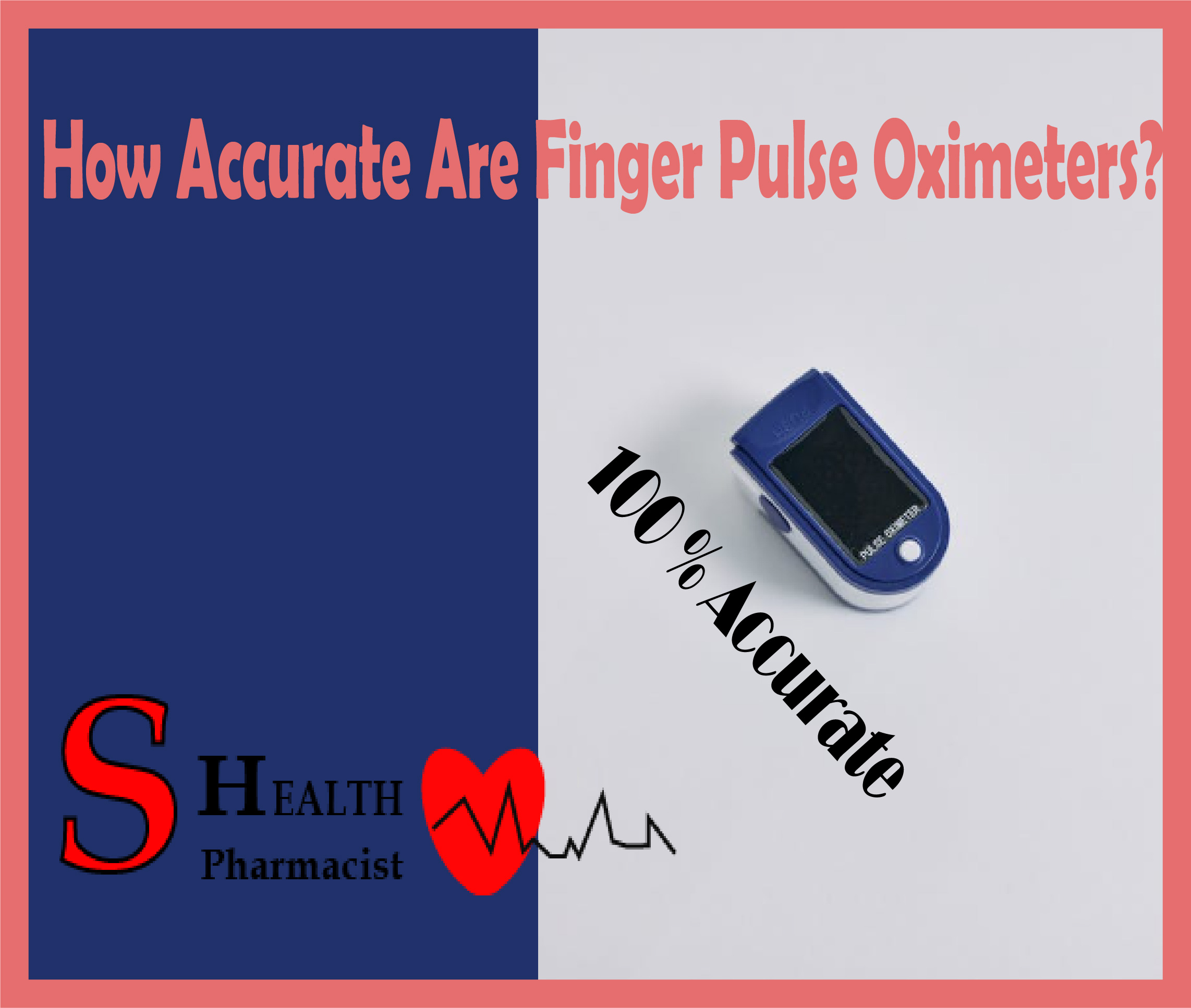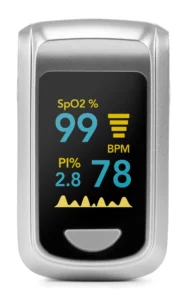Pulse oximetry is a technique for determining saturation, or the level of oxygen saturation of hemoglobin in the blood.
This is a vital indicator that ensures the normal functioning of the cells and tissues of the body.
With coronavirus, the saturation level can rapidly decrease due to pneumonia, so it is important to keep a record of the measurement results.
But How Accurate Are Finger Pulse Oximeters? Let’s figure it out today together…
Oxiline Pulse X Pro is currently the best fingertip pulse oximeter on the market with the easiest adjustment to your smartphone.
It can measure your Saturation Measurements and Perfusion Index in several seconds with 99% accuracy!
Table of Contents
What is the Work Principle of Any Pulse Oximeter?
This is the principle how any pulse oximeter works:
- The measurements are carried out by the optical method of data analysis.
- An emitter is installed in the sensor of a portable pulse oximeter, which delivers 2 light waves of the red and infrared range of radiation into the tissues and capillary blood.
- Some of the light is absorbed by the hemoglobin in the blood, and the level of light absorption depends on the saturation of the hemoglobin with oxygen.
- The unabsorbed light is sensed by a capturing photosensor, and then an analysis of the degree of light absorption is performed in the microprocessor.
- Data on oxygen saturation and pulse rate are displayed in numerical terms.
How Accurate are Finger Pulse Oximeters?
Usually, Wristband pulse oximeters tend to provide reasonably accurate reliable results, even for people doing household chores. However, movement still interferes with the SpO2 determination, so sometimes the device makes mistakes and gives an incorrect result.
From the fingertip pulse oximeters, the best oximeter in the market right now is Pulse X Pro, Check out my full review here.
Oxiline Pulse X Pro is currently the best fingertip pulse oximeter on the market with the easiest adjustment to your smartphone.
No one has compared “Fingertip” and “wrists” pulse oximeters.
But so far fingertip pulse oximeters seem still more reliable for healthy people who are constantly moving and not lying-in bed to use clip-on pulse oximeters for self-monitoring during coronavirus disease.
Even if you choose the best pulse oximeter which is accurate there are always many external factors that affect how accurate pulse oximeter can be
The following factors should be taken into account:
1. Abnormal Hemoglobin
The blood may contain abnormal hemoglobin. Carboxyhemoglobin and methemoglobin are not involved in oxygen delivery.
The presence of these types of hemoglobin in the blood can lead to errors in SpO2 measurements.
For example, carbon monoxide poisoning (high concentrations of carboxyhemoglobin) can give a saturation value of about 100%.
Anemia requires higher oxygen levels to ensure oxygen transport. At hemoglobin values below 5 g / l, 100% blood saturation can be observed even with a lack of oxygen.

2.Medical Dyes
The presence of medical dyes in the blood of a patient can lead to distortions in the passage of red and infrared waves through tissues and distort the measurement results.
These dyes include methylene blue, indocyanine green, indigo carmine, fluorescein.
3. Manicure and pedicure
Nail polish or Gel nails can cause inaccurate SpO2 readings because they can reduce and distort the waves emitted by the pulse oximeter probe.
4. Movement of the finger in the sensor caused by the movement of the body
Finger movement in the sensor can cause noise that will affect SpO2 and heart rate calculations.
5. Blockage of blood flow in the arteries and fingers
The possibility or impossibility of performing measurements depends on the degree of pulsations in the arteries. If there is a blockage of blood flow, then the accuracy of the measurements drops.
In addition, with kinks or increased pressure on the fingers, for example, when exercising on an exercise bike.
The increased pressure in the finger can lead to distortion of the light waves and measurement errors.
6. Poor peripheral circulation
A significant decrease in perfusion of peripheral tissues (cold, shock, hypothermia, hypovolemia) leads to a decrease or disappearance of the pulse wave.
If there is no visible pulse wave on the pulse oximeter, any saturation percentage numbers are of little value.
If the hands are cold or the peripheral circulation is insufficient, it is necessary to increase the blood flow by massaging or warming up the fingers.
7. Bright light (Shadowless lamps, fluorescent lamps, IR lamps, direct sunlight, etc.)
The pulse oximeter is usually shielded from ambient light. However, if the lighting is too strong, it can lead to errors.
It is necessary to protect the sensor from the rays of powerful shadowless lamps and infrared lamps. For example, hide the hand with the sensor under the coat or in the armpit.
8. Surrounding electromagnetic waves
Nearby electrical appliances that are sources of strong electromagnetic waves, such as televisions, mobile phones, microwave ovens, copiers, computers, medical devices, can affect the measurement accuracy and operation of the pulse oximeter.
9. Incorrect sensor position
It is necessary that both parts of the sensor are symmetrical, otherwise the path between the photodetector and the LEDs will not be the same and one of the wavelengths will be “overloaded”.
Changing the position of the sensor often results in a sudden “improvement” in saturation, when in fact these are just device errors.
What To Do If There Are No Pulse Oximeters?
It’s easy to miss Low saturation.
Patients do not feel shortness of breath subjectively, but they have severe weakness, and it is an analogue of shortness of breath.
Saturation of 93% may not be accompanied by arousal and anxiety. Often at the same time, the patient simply cannot get up and walk to the computer, telephone, toilet, experiencing increased sleepiness.
Reason for re-call a doctor in patients under 60 years of age:
- Fever above 38 ° C
- Continued weakness.
- Drop in saturation on the 5-9th day of illness to 95% and below with an initial saturation of 98-99%.
Patients over 60 years of age are initially at risk, so you can not focus on saturation, but take into account only fever, weakness.
If these signs are observed, it is necessary to call a doctor, even if the saturation is 95-96%.
Final Words
Pulse oximeters can be expensive and cheap.
Expensive pulse oximeters cost more than 20 USDand generally consistently give accurate readings under adverse conditions.
Cheap pulse oximeters cost less than 10 USD and are divided into two categories: cheap good ones, which simply turn off in case of unfavorable measurement conditions, and cheap bad ones, which begin to give false readings in suboptimal conditions.
A simple test can allow you to distinguish a good quality and bad quality pulse oximeters:
If you raise your finger with a pulse oximeter over your head during a measurement, then at a certain point a good pulse oximeter will turn off. A bad pulse oximeter in this situation will underestimate the saturation value.
And always remember even if you choose the best pulse oximeter which is accurate there are always many external factors that affect the results of the pulse oximeter.
FAQ
Which Finger is Most Accurate for Pulse Oximeter?
The clip sensor is attached to the index finger of the hand.
It is not recommended to simultaneously install the sensor and the cuff of a medical tonometer on the same limb, since in this case the result of measuring saturation is distorted.
Which is a Normal Reading on a Finger Pulse Oximeter?
Pulse oximetry evaluates blood saturation and heart rate (pulse). The resting heart rate in an adult is 60 to 90 beats per minute.
A saturation of 95% or more is considered normal.
Does a Smart Watch Show Accurate Readings?
There are LEDs and sensors on the back of the watch. As in pulse oximeters, the LEDs “shine through” the arteries, but the light does not pass through, but is reflected from the blood vessels and hits the sensors, which transmit it to the application. So, the measurements can be inaccurate.
